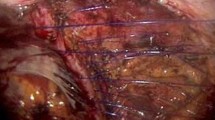Abstract
Background
Because of the lack of published data and the relative rarity of lateral incisional hernia (LIH), their repair remains a major challenge for surgeons. The aim of the present study was to evaluate the outcome of LIH treated by the retromuscular approach (RMA) with a polyester standard mesh.
Methods
Sixty-one patients were treated between June 2000 and November 2007 in an academic tertiary referral center using one standardized surgical technique and one type of mesh. Lumbar incisional hernia was excluded. All data were prospectively culled. The early complications and recurrence rates were evaluated.
Results
There were 14 (23 %) subcostal, 12 (19.6 %) flank, and 35 (57.4 %) iliac fossa LIH. The mean patient age was 57 years, and 60 % were male. The average width of the defect was 7.6 cm and the overall defect size averaged 56 cm². Seventeen patients (28 %) had had previous LIH repair. Ten patients had double hernia locations (midline and lateral) repaired simultaneously. The average operative time and hospital stay were 136 min and 7 days, respectively. The early complications rate was 18 %. Four patients required reoperation. There were no mesh infections. The median follow-up was 47 months (range: 1–125 months). Recurrence was observed in three patients (4.9 %).
Conclusions
LIH repair by RMA with a polyester heavyweight mesh proves to be a safe treatment with a moderate complication rate and a low infection rate, even in the treatment of large or multifocal parietal defects.
Similar content being viewed by others
References
Iannitti DA, Hope WW, Norton HJ et al (2008) Technique and outcomes of abdominal incisional hernia repair using a synthetic composite mesh: a report of 455 cases. J Am Coll Surg 206:83–88
Gleysteen JJ (2009) Mesh-reinforced ventral hernia repair: preference for 2 techniques. Arch Surg 144:740–745
Muysoms FE, Miserez M, Berrevoet F et al (2009) Classification of primary and incisional abdominal wall hernias. Hernia 13:407–414
Greenall MJ, Evans M, Pollock AV (1980) Midline or transverse laparotomy? A random controlled clinical trial. Part I: influence on healing. Br J Surg 67:188–190
Kendall SW, Brennan TG, Guillou PJ (1991) Suture length to wound length ratio and the integrity of midline and lateral paramedian incisions. Br J Surg 78:705–707
Halm JA, Lip H, Schmitz PI et al (2009) Incisional hernia after upper abdominal surgery: a randomised controlled trial of midline versus transverse incision. Hernia 13:275–280
Ferrari GC, Miranda A, Sansonna F et al (2009) Laparoscopic repair of incisional hernias located on the abdominal borders: a retrospective critical review. Surg Laparosc Endosc Percutan Tech 19:348–352
Morrison CP, Wemyss-Holden SA, Iswariah H et al (2002) Lateral laparoscopic port sites should all be closed: the incisional “spigelian” hernia. Surg Endosc 16:1364
Moreno-Egea A, Carrillo A, Aguayo JL (2008) Midline versus nonmidline laparoscopic incisional hernioplasty: a comparative study. Surg Endosc 22:744–749
Stumpf M, Conze J, Prescher A et al (2009) The lateral incisional hernia: anatomical considerations for a standardized retromuscular sublay repair. Hernia 13:293–297
Langer S, Christiansen J (1985) Long-term results after incisional hernia repair. Acta Chir Scand 151:217–219
Luijendijk RW, Hop WC, van den Tol MP et al (2000) A comparison of suture repair with mesh repair for incisional hernia. N Engl J Med 343:392–398
Sauerland S, Walgenbach M, Habermalz B et al (2011) Laparoscopic versus open surgical techniques for ventral or incisional hernia repair. Cochrane Database Syst Rev 3:CD007781
Gurusamy KS, Samraj K (2007) Wound drains after incisional hernia repair. Cochrane Database Syst Rev: CD005570
White TJ, Santos MC, Thompson JS (1998) Factors affecting wound complications in repair of ventral hernias. Am Surg 64:276–280
Poghosyan T, Veyrie N, Corigliano N et al (2012) Retromuscular mesh repair of midline incisional hernia with polyester standard mesh: monocentric experience of 261 consecutive patients with a 5-year follow-up. World J Surg 36:782–790. doi:10.1007/s00268-012-1443-1 discussion 791–782
Pessaux P, Msika S, Atalla D et al (2003) Risk factors for postoperative infectious complications in noncolorectal abdominal surgery: a multivariate analysis based on a prospective multicenter study of 4718 patients. Arch Surg 138:314–324
Cassar K, Munro A (2002) Surgical treatment of incisional hernia. Br J Surg 89:534–545
Mudge M, Hughes LE (1985) Incisional hernia: a 10 year prospective study of incidence and attitudes. Br J Surg 72:70–71
Takagi H, Sugimoto M, Kato T et al (2007) Postoperative incision hernia in patients with abdominal aortic aneurysm and aortoiliac occlusive disease: a systematic review. Eur J Vasc Endovasc Surg 33:177–181
Welty G, Klinge U, Klosterhalfen B et al (2001) Functional impairment and complaints following incisional hernia repair with different polypropylene meshes. Hernia 5:142–147
Weyhe D, Belyaev O, Muller C et al (2007) Improving outcomes in hernia repair by the use of light meshes—a comparison of different implant constructions based on a critical appraisal of the literature. World J Surg 31:234–244. doi:10.1007/s00268-006-0123-4
Schmidbauer S, Ladurner R, Hallfeldt KK et al (2005) Heavy-weight versus low-weight polypropylene meshes for open sublay mesh repair of incisional hernia. Eur J Med Res 10:247–253
Junge K, Klinge U, Rosch R et al (2007) Improved collagen type I/III ratio at the interface of gentamicin-supplemented polyvinylidenfluoride mesh materials. Langenbecks Arch Surg 392:465–471
den Hartog D, Dur AH, Tuinebreijer WE et al. (2008) Open surgical procedures for incisional hernias. Cochrane Database Syst Rev: CD006438
Author information
Authors and Affiliations
Corresponding author
Additional information
Nicolas Veyrie and Tigran Poghosyan contributed equally to this work.
Rights and permissions
About this article
Cite this article
Veyrie, N., Poghosyan, T., Corigliano, N. et al. Lateral Incisional Hernia Repair by the Retromuscular Approach with Polyester Standard Mesh: Topographic Considerations and Long-term Follow-up of 61 Consecutive Patients. World J Surg 37, 538–544 (2013). https://doi.org/10.1007/s00268-012-1857-9
Published:
Issue Date:
DOI: https://doi.org/10.1007/s00268-012-1857-9




